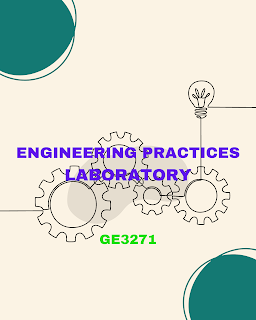Sub Code : GE3271
Sub Name : ENGINEERING PRACTICES LABORATORY
COURSE OBJECTIVES
The main learning objective of this course is to provide hands on training to the students in:
- Drawing pipe line plan; laying and connecting various pipe fittings used in common household plumbing work; Sawing; planing; making joints in wood materials used in common household wood work.
- Wiring various electrical joints in common household electrical wire work.
- Welding various joints in steel plates using arc welding work; Machining various simple processes like turning, drilling, tapping in parts; Assembling simple mechanical assembly of common household equipments; Making a tray out of metal sheet using sheet metal work.
- Soldering and testing simple electronic circuits; Assembling and testing simple electronic components on PCB.
GROUP – A (CIVIL & ELECTRICAL)
PART I
CIVIL ENGINEERING PRACTICES 15 PLUMBING WORK
- Connecting various basic pipe fittings like valves, taps, coupling, unions, reducers, elbows and other components which are commonly used in household.
- Preparing plumbing line sketches.
- Laying pipe connection to the suction side of a pump
- Laying pipe connection to the delivery side of a pump.
- Connecting pipes of different materials: Metal, plastic and flexible pipes used in household appliances.
WOOD WORK
- Sawing
- Planing and
- Making joints like T-Joint, Mortise joint and Tenon joint and Dovetail joint.
Wood Work Study
- Studying joints in door panels and wooden furniture
- Studying common industrial trusses using models.
PART II
ELECTRICAL ENGINEERING PRACTICES
Introduction to switches, fuses, indicators and lamps - Basic switch board wiring with lamp, fan and three pin socket
Staircase wiring
Fluorescent Lamp wiring with introduction to CFL and LED types.
Energy meter wiring and related calculations/ calibration
Study of Iron Box wiring and assembly
Study of Fan Regulator (Resistor type and Electronic type using Diac/Triac/quadrac)
Study of emergency lamp wiring/Water heater
GROUP – B (MECHANICAL AND ELECTRONICS)
PART III
MECHANICAL ENGINEERING PRACTICES
WELDING WORK
- Welding of Butt Joints, Lap Joints, and Tee Joints using arc welding.
- Practicing gas welding.
BASIC MACHINING WORK
- (simple)Turning.
- (simple)Drilling.
- (simple)Tapping.
ASSEMBLY WORK
- Assembling a centrifugal pump.
- Assembling a household mixer.
- Assembling an airconditioner.
SHEET METAL WORK
- Making of a square tray
- Demonstrating basic foundry operations.
PART IV
ELECTRONIC ENGINEERING PRACTICES
SOLDERING WORK
- Soldering simple electronic circuits and checking continuity.
ELECTRONIC ASSEMBLY AND TESTING WORK
- Assembling and testing electronic components on a small PCB.
ELECTRONIC EQUIPMENT STUDY
- Study an elements of smart phone.
- Assembly and dismantle of LED TV.
- Assembly and dismantle of computer/ laptop
TOTAL = 60 PERIODS
COURSE OUTCOMES
Upon completion of this course, the students will be able to:
- Draw pipe line plan; lay and connect various pipe fittings used in common household plumbing work; Saw; plan; make joints in wood materials used in common household wood work.
- Wire various electrical joints in common household electrical wire work.
- Weld various joints in steel plates using arc welding work; Machine various simple processes like turning, drilling, tapping in parts; Assemble simple mechanical assembly of common household equipments; Make a tray out of metal sheet using sheet metal work.
- Solder and test simple electronic circuits; Assemble and test simple electronic components on PCB.




